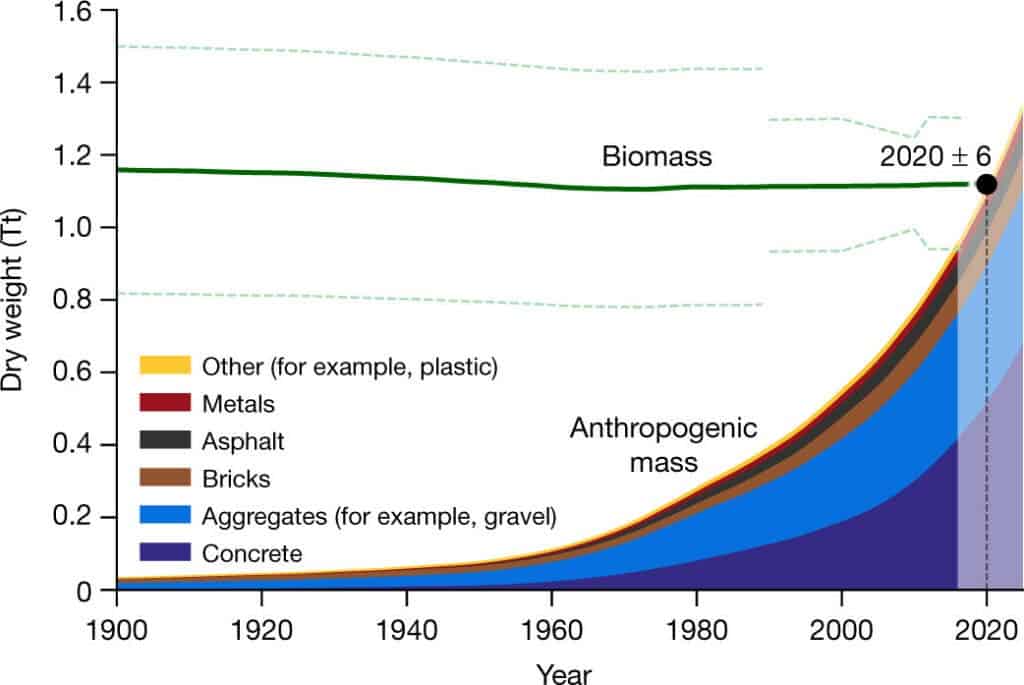Since the Industrial Revolution kicked off, we’ve built a lot of stuff. That’s just part of humanity most would probably say, from roads and homes to all sorts of vehicles, we need things. But we may have gone a bit over the lin here.
According to a new study, human-made objects now weigh about as much as all of the living beings on Earth and could even exceed it this year.

Humanity has gradually become a dominant force in shaping the face of Earth. Its impacts have been so abrupt and considerable that it has been proposed that the current geological epoch, the Holocene, be renamed the Anthropocene. The word comes from the Greek words Anthropos, for “man,” and cene for “new” — so we’ve basically ushered in a new geologic age through our actions.
This led researchers at Israel’s Weizmann Institute of Science to wonder how much material human activities have output, and how this compares to the overall natural biomass. They had already published an estimate of the amount of biomass on Earth and now decided to take it a step further, looking at artificial objects and comparing it with natural mass.
“The study provides a symbolic and mass-based quantitative characterization of the Anthropocene,'” two of the study’s authors, Emily Elhacham and Ron Milo, told Scientific American. “Given the empirical evidence on the accumulated mass of human artifacts, we can no longer deny our central role in the natural world.”
For the study, the researchers divided all the human-made objects into six main categories: concrete, aggregates (including materials like gravel), bricks, asphalt, metals, and “other” materials, which includes plastic, wood used for construction, paper, and glass. They didn’t consider waste in their calculations, which means the total man-made mass is already even higher than the researchers’ calculation.
They found that all the man-made objects weigh in at approximately 1.1 trillion metric tons. This is equal to the combined dry weight of all plants, animals, fungi, bacteria, archaea, and protists on the planet.

For this comparison scale, mankind works on both ends: it’s not just the construction of man-made objects, but also the destruction of natural landscapes. Since the first agricultural revolution, humanity has roughly halved the mass of plants, from approximately two teratons down to the current value of approximately 1.1 teratons. The total mass of domesticated crops is vastly outweighed by the loss of plant mass resulting from deforestation and other land-use change — obviously, a healthy forest with tall trees heavily outweighs the same size covered by wheat or other agricultural plants.
This is also not the end of it. The year 2020 could be when human-made mass surpasses the overall weight of biomass, the researchers estimate. Human-made mass is produced at a rate of 30 gigatons per year. This means materials outweighing the bodyweight of every person on the planet are being produced each week.
“The impacts of human activities have been so abrupt and considerable that it has been proposed that the current geological epoch be renamed the Anthropocene. Our study rigorously and quantitatively substantiates this proposal. In parallel, it adds another dimension to this discussion—a symbolic quantitative demarcation of the transition to our epoch,” the researchers wrote.
Despite the scientists describe the finding as symbolic, they argue the milepost provides humanity with a chance to review how we got here and what the future looks like. It’s a strong message to everyone and brings attention to how modern societies can grow sustainably in the upcoming future.
The study was published in the journal Nature.






